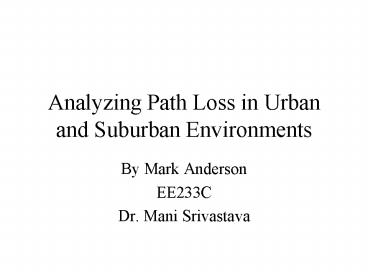Analyzing Path Loss in Urban and Suburban Environments PowerPoint PPT Presentation
1 / 18
Title: Analyzing Path Loss in Urban and Suburban Environments
1
Analyzing Path Loss in Urban and Suburban
Environments
- By Mark Anderson
- EE233C
- Dr. Mani Srivastava
2
Link Analysis
- Link Budget
- Transmitter antenna gain
- Receiver antenna and amplifier gain
- Path Loss Free space, shadowing
- Slope-intercept approximation for far-field (gt 1
m)
3
Outline
- Empirical Measurements
- Model Parameters
- Model
- Basic Model
- Simplifying
- At/Above/Below Avg Building Height
- Compare to Empirical Results
- Conclude
4
Empirical Shortcomings
- Empirical Data
- Measure signal response at a frequency per
distance - In specific sub/urban environment
- Pro
- Exact match for system under consideration
- Cons
- Expensive (mounting antennae, averaging
fast-fade, expensive measuring equipment and
personnel, multiple locations) - Cant generalize (frequency, environment)
5
Model Dimensions
Base station
Mobile station
R
?
?hb
?hm
w
d
x
6
Simple Model
- Path Loss has three terms
- Free Space - Lfs
- Attenuation from distance to point source
- Diffraction, roof-to-street Lrts
- Edges of buildings diffract signal between
buildings - Diffraction, multiple Lmd
- Multiple diffractions further attentuate signal
as it passes rows of buildings
7
Free Space
- Related to frequency and distance from base
antenna - Surface of sphere (far-field approximation)
- Point source approximation
- Ignore curvature
8
Roof-to-Street Diffraction
- Edges of building act as diffractors
- Both sides diffract down into street
9
Multiple-Diffraction
- Chained diffraction through rows of buildings
- QM is very complicated, with infinite summations
of recursive functions - Most simplifications of the model involve
simplifying assumptions about QM
10
Choices for Base Antennae Location
- At Average Building Height
- Cheap (licensing, site availability, zoning)
- Limits range of antennae
- Above Average Building Height
- Expensive
- Best reception (least occlusion) (closest to LOS)
- Below Building Height
- Cheapest
- Increases in Network capacity from smaller cells
11
Coverage Examples
- Base antenna height has a strong effect on
coverage patterns (8 m Bldg)
12
Near Rooftop Base Antennae
13
Above Rooftop Base Antennae
14
Below Rooftop Base Antennae
15
Comparison
- Near Rooftop
- Above Rooftop
- Below Rooftop
- Line of Sight (LOS)
- 20 dB/decade R and 20 dB/decade f
16
Empirical/Model Comparison
- Above Rooftops
- Antenna 100 ft
- 2 vs. 4-story
- 12 dB
- Close match for
- New Jersey (suburban)
- Tokyo/New York
17
Conclusion
- Good model
- Saves cost in estimating system buildout
- Accurate across various environments
18
Paper Figure

